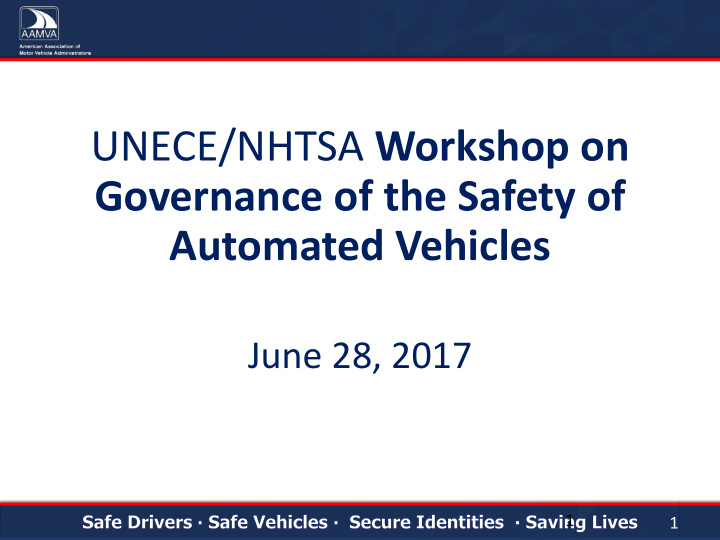



UNECE/NHTSA Workshop on Governance of the Safety of Automated Vehicles June 28, 2017 1 1
• American Association of Motor Vehicle Administrators (AAMVA) at a glance • Highly Automated Vehicles and AAMVA member collaboration • U.S. Model State Policy • It’s all about the Driver – but who is that? 2 2
• Founded in 1933 • Uniformity and reciprocity across North America • Collaboration, exchange of best practices • Network through meetings, conferences and IT systems 3
4
AAMVA Board of Directors Driver Law Vehicle Driver Vehicle Committee Enforcement Committee Committee Committee Committee Working Working Working Working Working Working Group Group Group Group Group Group Autonomous Vehicle Working Group 5
1. Autonomous Vehicle Information Sharing Group and Library 2. Autonomous Vehicle Working Group. 6
• Established in December 2013. • Monthly calls to review state laws, studies, stakeholder view and other relevant material. • Started with about 20 people participating and has grown to 60 to 80 people. Representing jurisdictions, federal government and industry partners. AV Information Library on AAMVA’s website: http://www.aamva.org/Autonomous-Vehicle- Information-Library/ 7 7
• 16 jurisdictional members, NHTSA and AAMVA staff • NHTSA funded project for first 2 years Three sub-groups focusing on issues impacting: • Drivers: Licensing & Testing • Vehicles: Titling & Registration • Law Enforcement: Concerns & Challenges 8
1. Provided significant input for the NHTSA Model State Policy - Published September 20, 2016 2. Concurrent with the Model State Policy development, the Working Group will complete Guidelines for the Regulation of Highly Automated Vehicles , a final piece of its work in support of the Model State Policy. Anticipated December 2017 or January 2018 9
Published September 2016 and can be found at www.transportation.gov/AV Section 1 – Vehicle Performance Guidance for Automated Vehicles (outlines best practices for safe pre- deployment development and testing prior to commercial sale; sets USDOT expectations of industry). The Guidance includes a 15-Point Safety Assessment to set clear expectations for manufacturers developing and deploying automated vehicle technologies. 10
Section 2 – Model State Policy Recognizes states’ sovereignty while encouraging a consistent national framework rather than a patchwork of inconsistent laws. References partnership with AAMVA. Federal Responsibilities State Responsibilities The Model State Policy 11
• Federal responsibilities include: • Setting safety standards for new motor vehicles and motor vehicle equipment; Enforcing compliance with the safety standards; • Investigating and managing the recall and remedy of non- compliances and safety-related motor vehicle defects on a nationwide basis; • Communicating with and educating the public about motor vehicle safety issues; and • When necessary, issuing guidance to achieve national safety goals. 12
• State responsibilities include: • Licensing (human) drivers and registering motor vehicles in their jurisdictions; • Enacting and enforcing traffic laws and regulations; • Conducting safety inspections, when States choose to do so; and • Regulating motor vehicle insurance and liability. 13
Model framework - covers 10 areas: 1. Administrative – Cross-Divisional 2. Application by manufacturers or other entities to test HAVs on public roads 3. Jurisdictional permission to test 4. Testing by the manufacturer or other entities 14
5. Drivers of deployed vehicles 6. Registration and titling of deployed vehicles 7. Law enforcement considerations 8. Liability and insurance 9. NHTSA’s Enforcement Authority 10.Next Steps – more input; additional updates 15
• Experienced Drivers – how and when will they learn to use the new technology and understand it limitations • New Drivers – how will they be tested to handle Level 1 vehicles if appear in level 2 and newer • MyCarDoesWhat.org 16
My Car Does What? 17
• At what point and for what vehicles will a license no longer be required? • Need to consider the roles of driver vs operator vs occupant • Rules of the Road/Traffic laws under review • Transportation Research Board (National Academies) • Uniform Law Commission 18
• Iterative consideration how best to enable deployment of innovative (potentially life-saving) technologies with current public safety demands • Develop and sustain collaborative effort among government officials, stakeholders and industry 19 19
Cathie Curtis, Director of Vehicle Programs ccurtis@aamva.org Anne Ferro, President and CEO aferro@aamva.org 20
Recommend
More recommend